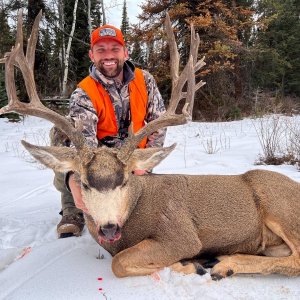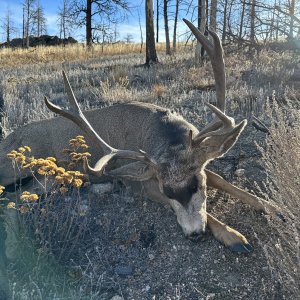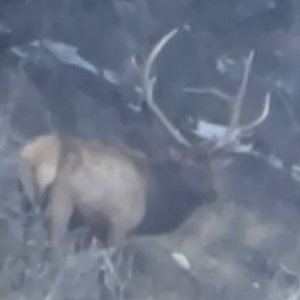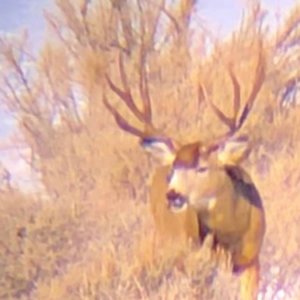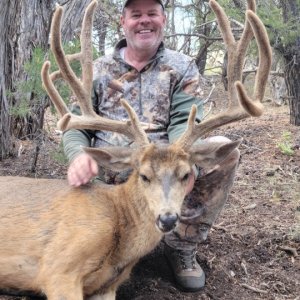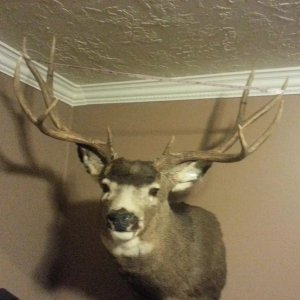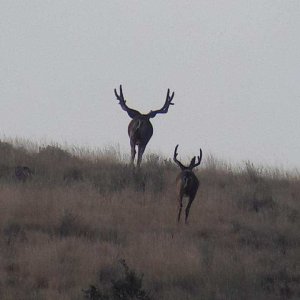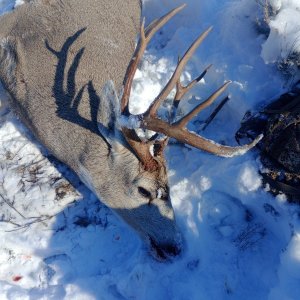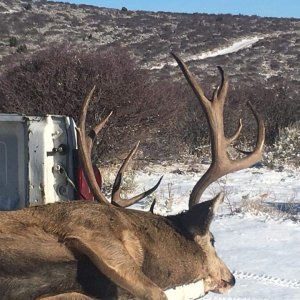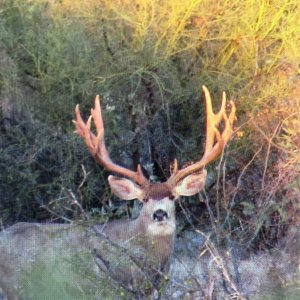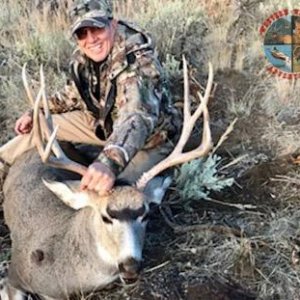You are using an out of date browser. It may not display this or other websites correctly.
You should upgrade or use an alternative browser.
You should upgrade or use an alternative browser.
2009 mule deer tags
- Thread starter NASCAR88
- Start date
H
huntindude
Guest
Might as well up them 40%, they have no intent on bringing deer numbers back anyway. this way they get to sell all the tags they want and don't have to contend with the depredation issues they'd have if we actually had deer.
ODFW doesn't need biologist, all they need are bean counters and someone to make sure you bought your tag.
ODFW doesn't need biologist, all they need are bean counters and someone to make sure you bought your tag.
H
HKShooter
Guest
When will they wake up and smell the cash from a long-term investment called......GAME MANAGEMENT............. Throwing up in the mouth is saying it best. Why give a crap? They need to SHUT DOWN most of our deer units for a couple years MINIMUM. And I don't believe too many HUNTERS would truly care, because if they hunt, they understand how piss poor it really is in this state!
HK
HK
NASCAR88
Active Member
- Messages
- 249
Since it is a money issue, I would be willing to pay more to apply for a hunt if they would lower the tag numbers. That way they would stil get the money they think they need and the deer herds should improve. But on the other hand by not taking care of the predators and poachers (indian tribes) I don't think lowering the tag amounts would really be that effective anyway.
H
huntindude
Guest
I agree if cutting tag numbers alone would do the trick I'd push hard for it, but even where hunter pressure is near nothing deer are near extinct. the biggest gain we'd see from cutting tags would be the lost revenue, that in itself would force ODFW to admit they have a problem and deal with it.
K
KILLERBEE
Guest
oh crud , here we go again
no really, it does tick me off that they let easy game management tactics go by each year.
1. why in the heck does the west side of oregon have to shoot a 2 point or better, when most of the time it is way thicker country making it harder top identify how many points they have, but the whole friekin east side is visable antler? [ most of the east side you should be able to identify the points]
stupid IMO
we could argue back and forth forever the toppic of whats a better managment plan, 3 point or better, 4 or better, hair tag, yadda-yadda. i say just make SOME buck illegal to shoot. i dont care if its a spike or what. thats a start.
another idiotic move i think--
3 yrs ago they made the ochoco unit a draw for archery elk.[good IMO] they also made it to where you CANNOT hunt archery muledeer in the unit unless you had the archery elk tag.{ GREAT IN MY OPINION] i'll would bet they lowerd the archery hunters by a couple thousand hunters easy. before it was a draw, archery was as packed as the rifle hunt and they were giving 5500 tags for the rifle.
after dropping the general archery to a draw { I think 600+/- tags] that was a HUGE jump in the right direction
you would think they would take advatage of that start and dropp the rifle tags also??? F-NO! so now you went from a ton of year old bucks getting shot from the roads in archery season to a ton of young buck being shot by rifle hunters......
STUPID AGAIN IMO
as far as predators go, we as hunters should really try and make an effort to kill more than we do. and in my opinion, even if it's "illegal" the guys out there who are running dogs for bobcats or just training need to be using the SSS rule alot more.
i could go on and on about some very ignorant , EASY problems that are being missed but--- another day
no really, it does tick me off that they let easy game management tactics go by each year.
1. why in the heck does the west side of oregon have to shoot a 2 point or better, when most of the time it is way thicker country making it harder top identify how many points they have, but the whole friekin east side is visable antler? [ most of the east side you should be able to identify the points]
stupid IMO
we could argue back and forth forever the toppic of whats a better managment plan, 3 point or better, 4 or better, hair tag, yadda-yadda. i say just make SOME buck illegal to shoot. i dont care if its a spike or what. thats a start.
another idiotic move i think--
3 yrs ago they made the ochoco unit a draw for archery elk.[good IMO] they also made it to where you CANNOT hunt archery muledeer in the unit unless you had the archery elk tag.{ GREAT IN MY OPINION] i'll would bet they lowerd the archery hunters by a couple thousand hunters easy. before it was a draw, archery was as packed as the rifle hunt and they were giving 5500 tags for the rifle.
after dropping the general archery to a draw { I think 600+/- tags] that was a HUGE jump in the right direction
you would think they would take advatage of that start and dropp the rifle tags also??? F-NO! so now you went from a ton of year old bucks getting shot from the roads in archery season to a ton of young buck being shot by rifle hunters......
STUPID AGAIN IMO
as far as predators go, we as hunters should really try and make an effort to kill more than we do. and in my opinion, even if it's "illegal" the guys out there who are running dogs for bobcats or just training need to be using the SSS rule alot more.
i could go on and on about some very ignorant , EASY problems that are being missed but--- another day
K
KILLERBEE
Guest
LAST EDITED ON Jun-10-09 AT 03:16PM (MST)[p]oh and another thing.
if money is an issue, add $ 2-5.00 to the tags or even apps i dont care. people who LOVE being out there will gladly pay it to have better hunting. the guys who really could care less and think of it as a chance to do alot of drinking with the buddies, might pass on it. it's a WIN WIN situation IMO
but until then, try and make the best of what we have. it's still better than sitting at home right?
if money is an issue, add $ 2-5.00 to the tags or even apps i dont care. people who LOVE being out there will gladly pay it to have better hunting. the guys who really could care less and think of it as a chance to do alot of drinking with the buddies, might pass on it. it's a WIN WIN situation IMO
but until then, try and make the best of what we have. it's still better than sitting at home right?
H
huntindude
Guest
Once again it's not overhunting in 90% of the cases where mule deer numbers are low. if it was I'd say cut the tag numbers in half and double the price. problem is if we did that ODFW would just say sweet now we can get by with half the deer we have today and run with it.
The deer numbers we have in eastern Oregon are not good enough, we've been making the best of it for 15 years and look where it's taken us. here agian until there is an organized push to force ODFW to address the issue we're screwed, and OHA is for sure not that voice all they are is yes men for ODFW.
So I'll hunt out of state for the most part and hope Oregon hunters reach a point they want action before the feds list the mule deer on the ESA, until then ODFW has become very good at politly blowing my opinions off and telling me it's the weather as the reason I don't see deer like I used to during season, too wet, too cold, too dry, too windy, too warm I've heard it all. they've het to come up with a good comeback as to why I don't see them in elk season or in my hay fields but they're working on it no doubt.
The deer numbers we have in eastern Oregon are not good enough, we've been making the best of it for 15 years and look where it's taken us. here agian until there is an organized push to force ODFW to address the issue we're screwed, and OHA is for sure not that voice all they are is yes men for ODFW.
So I'll hunt out of state for the most part and hope Oregon hunters reach a point they want action before the feds list the mule deer on the ESA, until then ODFW has become very good at politly blowing my opinions off and telling me it's the weather as the reason I don't see deer like I used to during season, too wet, too cold, too dry, too windy, too warm I've heard it all. they've het to come up with a good comeback as to why I don't see them in elk season or in my hay fields but they're working on it no doubt.
K
KILLERBEE
Guest
if it's not over hunting in 90% of the cases, what is it?
yes predation is alot of it. but that yours, mine,and any other hunters partial fault for not doing more about it. as far as lions ODFW cant do much more than we can. we all can blame alot of that to the fact we live in a highly populated tree hugger state.
theres nothing we can do about hard winters, like the one in the 90's that started alot of the western states decline in mule deer. thats mother nature
in the end the one thing that CAN BE DONE is to cut tags and impose antler restrictions. look at every private land/ indian rez/ quality hunting unit in america. it's better hunting because there is less opertunity to hunt it. there is a place to meet in the middle. less tags but not so you couldn't hunt for 10 yrs either
yes predation is alot of it. but that yours, mine,and any other hunters partial fault for not doing more about it. as far as lions ODFW cant do much more than we can. we all can blame alot of that to the fact we live in a highly populated tree hugger state.
theres nothing we can do about hard winters, like the one in the 90's that started alot of the western states decline in mule deer. thats mother nature
in the end the one thing that CAN BE DONE is to cut tags and impose antler restrictions. look at every private land/ indian rez/ quality hunting unit in america. it's better hunting because there is less opertunity to hunt it. there is a place to meet in the middle. less tags but not so you couldn't hunt for 10 yrs either
H
HKShooter
Guest
In 1962 more than 160K deer were harvested in Oregon. About 50K in 2003.
They need to shut down our worst units.
They need to put antler restriction on the others.
Everyone needs to do their part to get this state back to a respectable big game state. If we don't out children aren't going to have much fun never harvesting a buck.
HK
They need to shut down our worst units.
They need to put antler restriction on the others.
Everyone needs to do their part to get this state back to a respectable big game state. If we don't out children aren't going to have much fun never harvesting a buck.
HK
O
Oregonbowhunter
Guest
The problem with antler restrictions, and this is fact, is that people shoot an animal and when it's not a 4pt or better or 3pt or better they leave it. This is why most places don't have antler restrictions anymore.
Poaching is a huge problem, more than we know I'm sure. When you combine all the factors, it's no wonder we have any deer at all.
Let's add them up:
Predators
Poachers
Vehicle Collisions
Disease
Loss of Habitat
Hunter Harvest
Hard Winters
It's not just one problem
Poaching is a huge problem, more than we know I'm sure. When you combine all the factors, it's no wonder we have any deer at all.
Let's add them up:
Predators
Poachers
Vehicle Collisions
Disease
Loss of Habitat
Hunter Harvest
Hard Winters
It's not just one problem
NASCAR88
Active Member
- Messages
- 249
LAST EDITED ON Jun-11-09 AT 00:50AM (MST)[p]LAST EDITED ON Jun-11-09 AT 00:49?AM (MST)
It seems like since the good folks of portland and salem decided that using dogs to hunt cats and bears just isn't right was about when the decline started. I think the cats have something to do with it but you would think you would see one behind every tree if that was the case. I have been in the woods for 30 years and have only seen 2 cats, I know they are shy but if they were such a huge problem you would think a guy would see more. Maybe I'm just blind in one eye and can't see out of the other. Oregon has always had winters,disease,vehicle collisions,poachers and predators so who knows.
I think another factor is the stress on the animals, In Oregon there are hunts going on from Aug-Dec. Some of the other states get hunters in and out within a 1 month time frame and don't run the animals to death for 5 months.
It seems like since the good folks of portland and salem decided that using dogs to hunt cats and bears just isn't right was about when the decline started. I think the cats have something to do with it but you would think you would see one behind every tree if that was the case. I have been in the woods for 30 years and have only seen 2 cats, I know they are shy but if they were such a huge problem you would think a guy would see more. Maybe I'm just blind in one eye and can't see out of the other. Oregon has always had winters,disease,vehicle collisions,poachers and predators so who knows.
I think another factor is the stress on the animals, In Oregon there are hunts going on from Aug-Dec. Some of the other states get hunters in and out within a 1 month time frame and don't run the animals to death for 5 months.
S
scoutdog5
Guest
I am currently in the middle of researching research that has been done over the past few years on whitetail reproduction. If that research applies to Mule Deer, and I believe it does, there is no longer any doubt that the current buck ratio objectives of most western states, around 15 bucks/100 does, is not sufficient to maximize production in a population you want to increase.
For many years, the Holy Grail of reproduction has been pregnancy rates for females. The thinking was as long as the does are getting pregnant, the population will increase. Numerous research projects showed that even when buck ratios were as low as 10/100, the vast majority of does were impregnated.
The problem with that theory is it doesn't work in today's world. For example, the Ochoco unit has exceeded the Spring Fawn ratio of 35 fawns/100 does for 13 of the last 14 years, in some cases by substantial numbers. Given that fact, the population should have increased, in some years fairly substantially. Unfortunately, the unit population continues to go down, even when fawn ratios are high.
One of the interesting facts coming out of whitetail research is the huge difference in the number of fawns that are impregnated at 1.5 years of age. In the studies, fawns that are born in late May/early June (assuming good habitat) will have a 60% pregnancy rate the next fall. Fawns born later (or in poor habitat conditions) have a 10% pregnancy rate the next fall. Given that, if you want to maximize reproduction in the short term, it is critical that does are inpregnated during the first estrus cycle.
Where this really get's interesting is when they studied how whitetials breed. Unlike elk, where the dominant bull controls the herd of cows, and will breed multiple cows in one day, and do everything possible to prevent other bulls from breeding, dominant whitetail bucks will select one doe, and stay with her for 24-72 hours, attempting to breed her multiple times. Meanwhile, other less dominant bucks will breed other does that enter estrus during that period. In one study, the average no. of does bred by a particular buck was 5, the maximum was 9.
Now, assume this is how things work for mule deer, which I believe it does. In the Ochoco unit, the current count is 9 bucks/100 does. Add in the 2,000 female fawns that could be bred this fall, and you have 1 buck older than 1.5 years for every 14 does. Use the lower end of the range, 24 hours, and the most does that one buck will breed in the first estrus cycle is 5-6. Add in the vast distances mule deer inhabit compared to whitetails, and it is likely that only about 30% of the does are getting bred during the first estrus cycle.
So, the next spring-summer, the Ochoco herd will have fawns being born over 10-12 weeks, instead of 2-3 weeks, which greatly increases predation by coyotes and possibly bears. (Studies show that Cougars are equal opportunity killers, taking bucks, does and fawns throughout the year) Now you get to the next fall, and very few fawns are physically able to be bred, and the cycle continues.
This is a brief summary of the what I am finding, but it certainly is a potential explanation for what has been happening in many of our mule deer units over the past 30 years.
Scoutdog
For many years, the Holy Grail of reproduction has been pregnancy rates for females. The thinking was as long as the does are getting pregnant, the population will increase. Numerous research projects showed that even when buck ratios were as low as 10/100, the vast majority of does were impregnated.
The problem with that theory is it doesn't work in today's world. For example, the Ochoco unit has exceeded the Spring Fawn ratio of 35 fawns/100 does for 13 of the last 14 years, in some cases by substantial numbers. Given that fact, the population should have increased, in some years fairly substantially. Unfortunately, the unit population continues to go down, even when fawn ratios are high.
One of the interesting facts coming out of whitetail research is the huge difference in the number of fawns that are impregnated at 1.5 years of age. In the studies, fawns that are born in late May/early June (assuming good habitat) will have a 60% pregnancy rate the next fall. Fawns born later (or in poor habitat conditions) have a 10% pregnancy rate the next fall. Given that, if you want to maximize reproduction in the short term, it is critical that does are inpregnated during the first estrus cycle.
Where this really get's interesting is when they studied how whitetials breed. Unlike elk, where the dominant bull controls the herd of cows, and will breed multiple cows in one day, and do everything possible to prevent other bulls from breeding, dominant whitetail bucks will select one doe, and stay with her for 24-72 hours, attempting to breed her multiple times. Meanwhile, other less dominant bucks will breed other does that enter estrus during that period. In one study, the average no. of does bred by a particular buck was 5, the maximum was 9.
Now, assume this is how things work for mule deer, which I believe it does. In the Ochoco unit, the current count is 9 bucks/100 does. Add in the 2,000 female fawns that could be bred this fall, and you have 1 buck older than 1.5 years for every 14 does. Use the lower end of the range, 24 hours, and the most does that one buck will breed in the first estrus cycle is 5-6. Add in the vast distances mule deer inhabit compared to whitetails, and it is likely that only about 30% of the does are getting bred during the first estrus cycle.
So, the next spring-summer, the Ochoco herd will have fawns being born over 10-12 weeks, instead of 2-3 weeks, which greatly increases predation by coyotes and possibly bears. (Studies show that Cougars are equal opportunity killers, taking bucks, does and fawns throughout the year) Now you get to the next fall, and very few fawns are physically able to be bred, and the cycle continues.
This is a brief summary of the what I am finding, but it certainly is a potential explanation for what has been happening in many of our mule deer units over the past 30 years.
Scoutdog
H
huntindude
Guest
Scoutdog you might be onto something but I have to ask, what has changed to cause this?
The only thing I can say is worse than it was in the 60's and 70's are predators, we have way more yotes and way way more cats. we've had open winters, reduced tags,less grazing, fires which are good for deer, road closures and poaching is nothing compared to when I was a kid . I'm not saying you don't have a good theory but why has it changed? and what can we do to set it right again or can we?
Why have Colorado's mule deer done so well and Oregon's so poor? if not for the winter 2 years ago Colorado would be flooded with deer while we enjoyed an open winters and have no deer. yes they have great habitat , better than ours will ever be but our habitat is in good condition and could support the numbers we had in the 70's again I have no doubt. here is what I see, Colorado limits hunting better and they control the cats, I think that above all is where they shine and we suck.
The only thing I can say is worse than it was in the 60's and 70's are predators, we have way more yotes and way way more cats. we've had open winters, reduced tags,less grazing, fires which are good for deer, road closures and poaching is nothing compared to when I was a kid . I'm not saying you don't have a good theory but why has it changed? and what can we do to set it right again or can we?
Why have Colorado's mule deer done so well and Oregon's so poor? if not for the winter 2 years ago Colorado would be flooded with deer while we enjoyed an open winters and have no deer. yes they have great habitat , better than ours will ever be but our habitat is in good condition and could support the numbers we had in the 70's again I have no doubt. here is what I see, Colorado limits hunting better and they control the cats, I think that above all is where they shine and we suck.
NASCAR88
Active Member
- Messages
- 249
yeah, I think our habitat is just fine. Another thing I think would help would be to close down alot of the spur roads. I hunt elk in the chesnim unit and they close most roads and just leave the main roads open. Yes you have to pack out your animal 3-5 miles sometimes but it is worth it. I think all our roads give more access to poaching and having one state cop to cover 200 sq. miles dosen't work either.
S
scoutdog5
Guest
Huntindude, here are some additional thoughts, based on my research.
First Colorado. Throughout the 90's, Colorado's deer herds were decreasing much like Oregon's. Buck ratios of 15-20/100 does (higher than Oregon's, but not by much). In 1999 Colorado cut total mule deer tags to less than 50% of the year before, and every tag was limited entry. In 8 years, buck ratios increased to an average of 35/100 state wide, and fawn ratios typically in the 60/100 range. the population increased to approximately 600,000 mule deer. My prediction is, assuming no additional devastating winters in the next five years, Colorado mule deer numbers will increase dramatically. I have had numerous discussions with ODFW employees about Colorado, and they refuse to admit that higher buck ratios had anything to do with what happened over that 8 year period.
I started hunting in 1962 for mule deer in the Ochoco unit. Went with my family for several years before that in both the Maury and Ochoco units. I always find it interesting when people talk about how great the habitat was then, or how important logging was to supporting high deer populations. Although I can't speak for other parts of the state, none of that was a factor in Central Oregon.
When you look at the history of mule deer in Oregon, some interesting things show up. Deer populations were low in the early 30's, and Mule Deer sanctuary's, with no hunting, were set up on a number of units. As I recall, the one in the Ochoco unit was west of the North Fork of the Crooked River, but that could be wrong. In addition, the depression and very low road densities kept most people close to home. There were large areas in the Ochoco Unit that saw very little hunting pressure. Throughout the 30's, the number of mature bucks was increasing.
What happens next? World War II, millions of men are in the service, guns and ammo are very restricted, and very little harvest of mule deer took place. By the time the men came home, mule deer populations in this area had exploded, with
very high fawn survival rates, high numbers of mature bucks, etc. Even though the number of hunters and harvest began to increase very quickly in the 50's, the lack of access and excellent herd dynamics kept herds growing.
Typically, ODFW began issuing large numbers of doe tags, and harvest skyrocketed. By the late 60's, mule deer numbers were dropping in the Ochoco unit, but the doe tag numbers remained high for a number of additional years.
The peak of the population in the early 60's on the Ochoco unit likely exceeded 40,000 deer, based on the harvest that was occurring. At that time, the habitat was in much poorer shape than it is today, at least on the east end of the unit, mostly due to much higher grazing numbers and poor rotation practices. Substantial logging, particularly into the large roadless areas, really did not crank up til the early 70's. Road densities increased dramatically between 1070 and 1990, and with very high buck tag numbers, put tremendous pressure on the mature buck component of the population. Buck ratios have remained in the 10-18/100 does range for the past 30 years, and a high percentage of those are 1.5 year olds, hardly a mature buck.
There is no question that the banning of 1080 poison (in 1968, I believe) had a negative impact on deer populations due to Coyote predation of fawns, and certainly since 1994 Cougars are a very serious problem. I am convinced however, that the major underlying cause of the decline in populations on the unit is the lack of mature bucks during the breeding season.
At some point, a deer population decreases to the point where there is not enough breeding stock left to rebuild a population. There is little question in my mind that Oregon has reached that point on the Trout Creek Unit, the east side of the Steens, the Warner unit, the Snake River unit, and probably other areas I am not as familiar with. I am afraid that we are approaching that point on the portion of the Ochoco unit east of the North Fork of the Crooked River. Issuing 2,800 buck tags on that unit, given buck ratios of 9/100, is a potential disaster, and if conditions are good and a large kills occurs, that will likely be the final chapter in a long, sad story.
Scoutdog
First Colorado. Throughout the 90's, Colorado's deer herds were decreasing much like Oregon's. Buck ratios of 15-20/100 does (higher than Oregon's, but not by much). In 1999 Colorado cut total mule deer tags to less than 50% of the year before, and every tag was limited entry. In 8 years, buck ratios increased to an average of 35/100 state wide, and fawn ratios typically in the 60/100 range. the population increased to approximately 600,000 mule deer. My prediction is, assuming no additional devastating winters in the next five years, Colorado mule deer numbers will increase dramatically. I have had numerous discussions with ODFW employees about Colorado, and they refuse to admit that higher buck ratios had anything to do with what happened over that 8 year period.
I started hunting in 1962 for mule deer in the Ochoco unit. Went with my family for several years before that in both the Maury and Ochoco units. I always find it interesting when people talk about how great the habitat was then, or how important logging was to supporting high deer populations. Although I can't speak for other parts of the state, none of that was a factor in Central Oregon.
When you look at the history of mule deer in Oregon, some interesting things show up. Deer populations were low in the early 30's, and Mule Deer sanctuary's, with no hunting, were set up on a number of units. As I recall, the one in the Ochoco unit was west of the North Fork of the Crooked River, but that could be wrong. In addition, the depression and very low road densities kept most people close to home. There were large areas in the Ochoco Unit that saw very little hunting pressure. Throughout the 30's, the number of mature bucks was increasing.
What happens next? World War II, millions of men are in the service, guns and ammo are very restricted, and very little harvest of mule deer took place. By the time the men came home, mule deer populations in this area had exploded, with
very high fawn survival rates, high numbers of mature bucks, etc. Even though the number of hunters and harvest began to increase very quickly in the 50's, the lack of access and excellent herd dynamics kept herds growing.
Typically, ODFW began issuing large numbers of doe tags, and harvest skyrocketed. By the late 60's, mule deer numbers were dropping in the Ochoco unit, but the doe tag numbers remained high for a number of additional years.
The peak of the population in the early 60's on the Ochoco unit likely exceeded 40,000 deer, based on the harvest that was occurring. At that time, the habitat was in much poorer shape than it is today, at least on the east end of the unit, mostly due to much higher grazing numbers and poor rotation practices. Substantial logging, particularly into the large roadless areas, really did not crank up til the early 70's. Road densities increased dramatically between 1070 and 1990, and with very high buck tag numbers, put tremendous pressure on the mature buck component of the population. Buck ratios have remained in the 10-18/100 does range for the past 30 years, and a high percentage of those are 1.5 year olds, hardly a mature buck.
There is no question that the banning of 1080 poison (in 1968, I believe) had a negative impact on deer populations due to Coyote predation of fawns, and certainly since 1994 Cougars are a very serious problem. I am convinced however, that the major underlying cause of the decline in populations on the unit is the lack of mature bucks during the breeding season.
At some point, a deer population decreases to the point where there is not enough breeding stock left to rebuild a population. There is little question in my mind that Oregon has reached that point on the Trout Creek Unit, the east side of the Steens, the Warner unit, the Snake River unit, and probably other areas I am not as familiar with. I am afraid that we are approaching that point on the portion of the Ochoco unit east of the North Fork of the Crooked River. Issuing 2,800 buck tags on that unit, given buck ratios of 9/100, is a potential disaster, and if conditions are good and a large kills occurs, that will likely be the final chapter in a long, sad story.
Scoutdog
NASCAR88
Active Member
- Messages
- 249
I had a friend in high school that hunted the small Ochoco in the 80's. I remember they always took nice mature 4x4's now they have trouble finding a dang forked-horn. i have hunted the Ukiah unit for 25 yrs and it is getting bad but by the sounds of it not as bad as some other units but it is heading that way fast along with all the NE units.
S-Dog if we had a few guys thinking like yourself in the ODFW i think we could bring back our herds. I think ODFW knows what they need to do but they won't give up the money to do it. They have to know what they are doing is not working.
S-Dog if we had a few guys thinking like yourself in the ODFW i think we could bring back our herds. I think ODFW knows what they need to do but they won't give up the money to do it. They have to know what they are doing is not working.
H
huntindude
Guest
Scout you've done your homework I'll say that.
You might be onto something, the number of mature bucks is beyond poor and has been for some time. My place is in the Grizzly unit but I grew up hunting un the Ochoco and Murderers Creek unit mostly, as you say even as a kid there was no excuse you couldn't take a mature deer in either unit.
The one thing I use to think was elk were a major factor, and in some cases they can but I've decided in most cases elk aren't the downfall of the deer. when I was young if you saw an elk in the Ochoco's you had to tell everyone about it, if someone were to say they saw an elk on my ranch you'd call them a liar. now I have more elk than deer much of the time and if you see a nice buck in the ochocos that's much more exciting than a decent bull. the problem with the elk theory is when I hunted the Steens and Trout Creeks where elk numbers are very low for the amount of territory the deer numbers are as bad or worse than where there are elk. also when hunting deer in Colorado the deer are thick and the elk are too, I think many of us locals blamed the elk when really it was just the timing that gave us that idea.
I think predation is the major factor, I saw more lion sign in Murderers Creek than I did deer sign last year, the feral horses are an issue, but your idea of too few mature bucks is one ODFW should address as well. I won't hold my breath.
You might be onto something, the number of mature bucks is beyond poor and has been for some time. My place is in the Grizzly unit but I grew up hunting un the Ochoco and Murderers Creek unit mostly, as you say even as a kid there was no excuse you couldn't take a mature deer in either unit.
The one thing I use to think was elk were a major factor, and in some cases they can but I've decided in most cases elk aren't the downfall of the deer. when I was young if you saw an elk in the Ochoco's you had to tell everyone about it, if someone were to say they saw an elk on my ranch you'd call them a liar. now I have more elk than deer much of the time and if you see a nice buck in the ochocos that's much more exciting than a decent bull. the problem with the elk theory is when I hunted the Steens and Trout Creeks where elk numbers are very low for the amount of territory the deer numbers are as bad or worse than where there are elk. also when hunting deer in Colorado the deer are thick and the elk are too, I think many of us locals blamed the elk when really it was just the timing that gave us that idea.
I think predation is the major factor, I saw more lion sign in Murderers Creek than I did deer sign last year, the feral horses are an issue, but your idea of too few mature bucks is one ODFW should address as well. I won't hold my breath.
K
KILLERBEE
Guest
s-dog, good read! it makes alot of sence-- there is only a couple things we-- hunters-- or even game a fish can control. killing more coyotes,{ each one of us making a couple more trips each year to the woods to try a kill a couple} and cutting tag #s
i have a buddy who was against cow tags for ever. so to help out in his own little way, he would put him and his wife in for cow tags and then when they drew he would tear up the tag. thats been yrs ago, seems like now you would just have to not purchase the tag once you drew it. unfortunatly for a person to do that you would have to basically not hunt or build points for deer. but i'm sure alot of people know someone who wouldn't go hunting anyway, so we could try and get them to draw a tag and not buy it???
i have a buddy who was against cow tags for ever. so to help out in his own little way, he would put him and his wife in for cow tags and then when they drew he would tear up the tag. thats been yrs ago, seems like now you would just have to not purchase the tag once you drew it. unfortunatly for a person to do that you would have to basically not hunt or build points for deer. but i'm sure alot of people know someone who wouldn't go hunting anyway, so we could try and get them to draw a tag and not buy it???
M
manny15
Guest
>When will they wake up and
>smell the cash from a
>long-term investment called......GAME MANAGEMENT............. Throwing
>up in the mouth is
>saying it best. Why
>give a crap? They
>need to SHUT DOWN most
>of our deer units for
>a couple years MINIMUM.
>And I don't believe too
>many HUNTERS would truly care,
>because if they hunt, they
>understand how piss poor it
>really is in this state!
>
>
>HK
Simple...
when we stop buying the tags.....
>smell the cash from a
>long-term investment called......GAME MANAGEMENT............. Throwing
>up in the mouth is
>saying it best. Why
>give a crap? They
>need to SHUT DOWN most
>of our deer units for
>a couple years MINIMUM.
>And I don't believe too
>many HUNTERS would truly care,
>because if they hunt, they
>understand how piss poor it
>really is in this state!
>
>
>HK
Simple...
when we stop buying the tags.....

